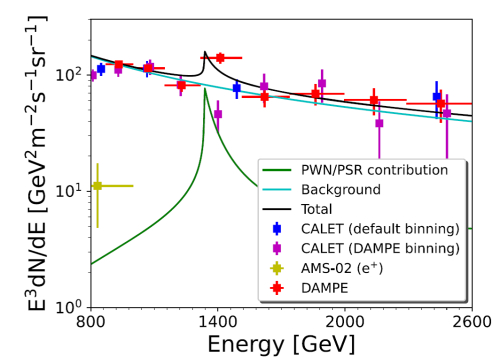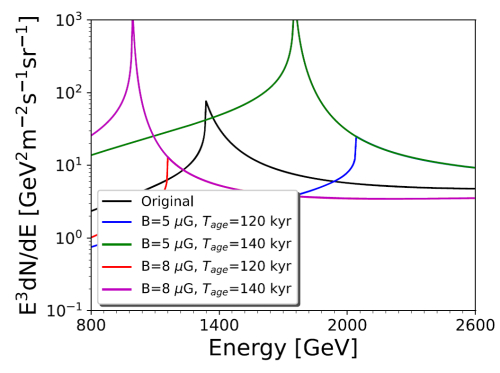Cosmic Ray Electron Spectral Lines Do Not Mean Dark Matter
One of the primary goals of the Dark Matter Particle Explorer Satellite (DAMPE) is to reveal signature of dark matter particle decay and/or annihilation in the cosmic ray electron spectrum. The first result of DAMPE shows that there is a spectral break just below 1 TeV and there is tentative signature of a spectral line near 1.4 TeV, which may be attributed to decay and/or annihilation of dark matter particles with similar energies. It is well known that particles in the standard model of particle physics can not give rise to such a spectral line. However, such a spectral line is not a surperise in the astrophysical context.
In a recent paper by BAO et al. in MNRAS, it is shown that a powerful nearby pulsar, namely PSR J0855-4644, can readily produce such an electron spectral line in the standard model for electron acceleration by pulsars and their nebulae. Such a spectral line arises from a combination of electron radiative energy loss processes and a very hard spectrum of accelerated electrons. The radiative energy loss rate of electrons inceases dramatically with the increase of the electron energy so that it takes higher energy electrons less time to lose a given fraction of their energy. Quantitatively, the energy loss rate is roughly proportional to the square of the energy. A hard spectrum means that most energy of the electron population is carried by electrons at the high-energy end of the energy distribution function. It turns out that, under the influence of radiative energy loss, a hard electron spectrum will quickly evolve into a distribution with a sharp spike at the high energy end due to rapid energy loss of electrons at even higher energies. The location of this high energy end therefore is determined by the "age" of the electron spectrum. For most pulsars, the electron acceleration mostly occurs within a few thousand years. The age of PSR J0855-4644 is about 140 thousand years. We therefore expect an electron spectral line in the TeV range, where electrons will lose most their energies over about 100 thousand years. Bao et al. surveyed all pulsars with an age near 150 thousand years and within 2 kiloparsec of the solar system. Four pulsars were found and PSR J0855-4644 is the most powerful one with a spin-down luminosity about 70 times more than that of the second powerful one. The green line in Fig. 1 shows its contribution to the electron spectrum. Fig. 2 shows the dependence of this contribution on the interstellar magnetic field and the pulsar age. It can be seen that the observed electron spectral hump near 1.4 TeV can be readily reproduced by such a model.

Fig. 1 Fit to the electron spectral line near 1.4 TeV with a pulsar model.

Fig. 2 Dependence of the electron spectral line on the pulsar age and interstellar magnetic field.
There is still a long way to go on the search for dark matter particles.